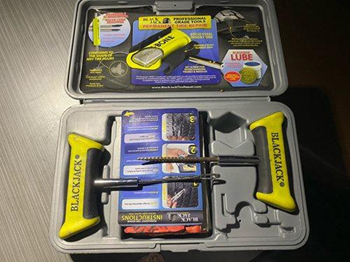
Hot weather is upon us again, so it’s the time of year when the gators come out. I’m not talking about the living ones. I’m talking about the tread that has peeled from a tire and is left on the road. Heat is the enemy of your tire. Over the winter, tires do not get as hot due to the lower ambient temperature. Summertime is not as forgiving regarding tire pressure, compared to cooler weather during winter. At higher temperatures, a tire begins to delaminate which is like deconstructing a tire. Running a tire low on air causes additional flex in the sidewall area, which weakens the tire’s carcass over time. The flexing of a tire’s sidewall also creates heat, which can cause damage to the tire. It’s important to remember they use heat to put a tire together, but heat will also take it apart. Keeping the correct tire pressure is always important, however, when the temperature rises, the tire’s resistance to failure decreases.
There are many ways to check your tire pressure correctly. You can use a traditional stick-type gauge, an electronic digital gauge, or a tire pressure monitoring system (TPMS). I prefer to have a TPMS on all my tires. The reason I have this system is that even if I diligently checked my tires with a gauge every time I stopped, there’s a possibility of running over a nail and causing a leak before I get the chance to check the tires with a gauge again. Using a tire thumper or a hammer to hit the tread of a tire is not the correct way to know if you have the proper tire inflation pressure.
In my case, I use the TireView by P.S.I. By having a TPMS, I have the assurance of knowing that all my tires are inflated correctly at all times during my travels. I have the warning pressure sensor set at 5 psi below the desired inflation pressure. On more than one occasion, I was warned of a slow leak on one of my tires before I started my pre-trip inspection. By having the TPMS I have saved many tires over the last 15 years of using a tire pressure monitor. Keep in mind that tire pressure monitoring systems are cheap when comparing them to replacing a tire, or the damage that can be caused by a tire’s low inflation pressure.
In addition to having a TPMS, I have found it very useful to carry an air hose that attaches to my air brake glad hand that can inflate tires. I like using the air off my truck and glad-hands because I’m assured nice, clean, dry air for my tires. Having clean dry air reduces the amount of moisture within a tire which cuts down the possibility of corrosion within my tire and wheel assembly. In addition to the air hose and the TPMS, I also carry a professional tire plug kit. I use the plug kit to temporarily fix a tire to safely get the damaged tire to a repair shop. If you do happen to use a tire plug kit, make sure to go to a repair facility to have the tire properly repaired with a patch. I found it extra important to take all the steps mentioned because my truck and trailer utilize wide-based single tires. This means if a tire fails, there is a good chance of the rim itself being damaged by the road service.
I strongly encourage everyone to have a tire pressure monitoring system and a professional tire plug kit in their truck’s toolbox. Getting a low tire pressure warning allows you to get to a safe place to stop and get it fixed, rather than having a damaged tire and having to stop on the side of the highway.
Until next time, be safe and profitable, and watch out for the gators on the road.